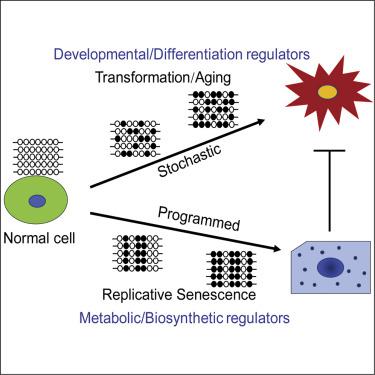当前位置:
X-MOL 学术
›
Cancer Cell
›
论文详情
Our official English website, www.x-mol.net, welcomes your feedback! (Note: you will need to create a separate account there.)
DNA Methylation Patterns Separate Senescence from Transformation Potential and Indicate Cancer Risk.
Cancer Cell ( IF 50.3 ) Pub Date : 2018-02-12 , DOI: 10.1016/j.ccell.2018.01.008 Wenbing Xie , Ioannis Kagiampakis , Lixia Pan , Yang W. Zhang , Lauren Murphy , Yong Tao , Xiangqian Kong , Byunghak Kang , Limin Xia , Filipe L.F. Carvalho , Subhojit Sen , Ray-Whay Chiu Yen , Cynthia A. Zahnow , Nita Ahuja , Stephen B. Baylin , Hariharan Easwaran
Cancer Cell ( IF 50.3 ) Pub Date : 2018-02-12 , DOI: 10.1016/j.ccell.2018.01.008 Wenbing Xie , Ioannis Kagiampakis , Lixia Pan , Yang W. Zhang , Lauren Murphy , Yong Tao , Xiangqian Kong , Byunghak Kang , Limin Xia , Filipe L.F. Carvalho , Subhojit Sen , Ray-Whay Chiu Yen , Cynthia A. Zahnow , Nita Ahuja , Stephen B. Baylin , Hariharan Easwaran

|
Overall shared DNA methylation patterns between senescence (Sen) and cancers have led to the model that tumor-promoting epigenetic patterns arise through senescence. We show that transformation-associated methylation changes arise stochastically and independently of programmatic changes during senescence. Promoter hypermethylation events in transformation involve primarily pro-survival and developmental genes, similarly modified in primary tumors. Senescence-associated hypermethylation mainly involves metabolic regulators and appears early in proliferating "near-senescent" cells, which can be immortalized but are refractory to transformation. Importantly, a subset of transformation-associated hypermethylated developmental genes exhibits highest methylation gains at all age-associated cancer risk states across tissue types. These epigenetic changes favoring cell self-renewal and survival, arising during tissue aging, are fundamentally important for stratifying cancer risk and concepts for cancer prevention.
中文翻译:

DNA甲基化模式将衰老与转化潜能分开,并表明患癌症的风险。
衰老(Sen)和癌症之间总体共有的DNA甲基化模式导致了该模型,即促进肿瘤的表观遗传模式是通过衰老产生的。我们表明,与转化相关的甲基化变化是随机发生的,并且与衰老过程中的程序变化无关。转化中的启动子高甲基化事件主要涉及生存基因和发育基因,在原发性肿瘤中也有类似的修饰。衰老相关的高甲基化主要涉及代谢调节剂,并出现在增殖的“近衰老”细胞的早期,该细胞可以被永生化,但难以转化。重要的是,在整个组织类型中,与年龄相关的所有癌症风险状态下,与转化相关的高甲基化发育基因的子集均表现出最高的甲基化增益。
更新日期:2018-02-13
中文翻译:

DNA甲基化模式将衰老与转化潜能分开,并表明患癌症的风险。
衰老(Sen)和癌症之间总体共有的DNA甲基化模式导致了该模型,即促进肿瘤的表观遗传模式是通过衰老产生的。我们表明,与转化相关的甲基化变化是随机发生的,并且与衰老过程中的程序变化无关。转化中的启动子高甲基化事件主要涉及生存基因和发育基因,在原发性肿瘤中也有类似的修饰。衰老相关的高甲基化主要涉及代谢调节剂,并出现在增殖的“近衰老”细胞的早期,该细胞可以被永生化,但难以转化。重要的是,在整个组织类型中,与年龄相关的所有癌症风险状态下,与转化相关的高甲基化发育基因的子集均表现出最高的甲基化增益。



























 京公网安备 11010802027423号
京公网安备 11010802027423号